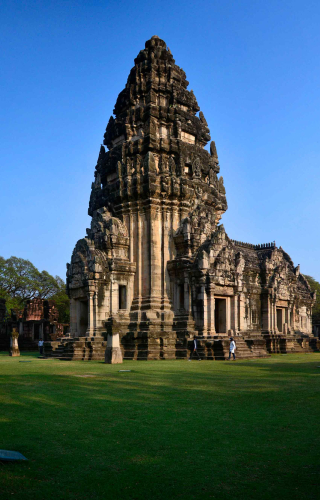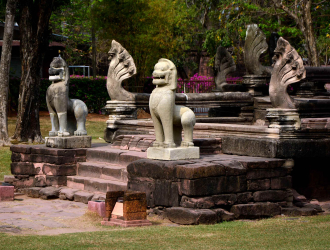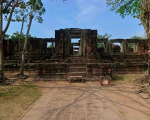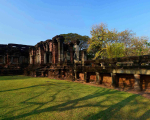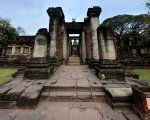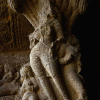Rome was not built in a day, neither was Angkor, mainland Southeast Asia’s dominant civilisation which flourished from the beginning of the ninth century till the mid-fifteenth century CE. Angkor’s greatest monument, Angkor Wat, was a culmination of centuries of temple building, design innovation and artistic refinement, which was first experimented on smaller temples. One such temple was located at Vimayapura, a frontier town in today’s Nakhon Ratchasima province in northeast Thailand. This is important because ancient Angkor is not just a single city in Cambodia, but a collection of cities scattered over Cambodia, Laos, Vietnam and Thailand.
These cities were connected to each other by a network of royal highways that allowed easy transport and human migration. Vimayapura was located on one of the longest highways—250 km—connecting Angkor’s capital at Yashodharapura to the Khorat Plateau. Many temples and arogyashalas (hospitals) dot this strategic route, including at Phanom Rung, Prasat Muang Kao, Prasat Huay Khaen, Prasat Muang Tam and Prasat Phanom Wan. The road continued further west to Lopburi, a major outpost of Angkor in the Chao Phraya River basin.
Vimayapura was initially a provincial capital but came into relevance in the late eleventh century when a power base was established there by Jayavarman VI (r. 1080–1107 CE). Jayavarman VI was not a legitimate claimant to the throne but had usurped it from Harshavarman III (r. 1066–80 CE), whose reign was fraught with internal rebellions and war with the Chams. This brought a new dynasty to power, and, for a period, Angkor was probably ruled simultaneously by two dynasties: one from the capital at Yashodharapura and the other from Vimayapura. This new dynasty, Mahidharapura, produced many later kings, including Suryavarman II, the builder of Angkor Wat, and Jayavarman VII. Vimayapura’s name is derived from Vimaya, a Sanskrit word meaning ‘one who has overcome the desire of maya (the illusion/misperception of reality)’, referring to the Buddha.
Vimayapura was not located in the heart of the empire, but far away, bordering the Mon kingdoms at Haripunjaya (modern Lamphun) and Lavo (modern Lopburi). Vimayapura’s location may have played a key role in how the new dynasty patronised religion. From the sixth century onwards, the Khorat Plateau was part of Dwaravati kingdom, which had developed a highly syncretic culture through longstanding contact and trade with India, Sri Lanka and Myanmar. Both Hinduism and Mahayana Buddhism was widely followed by the largely Mon-speaking population of Dwaravati, which finds a mention in the memoirs of Xuan Zhang, the Chinese monk who travelled to India from China in the seventh century.
Jayavarman VI commissioned a temple to enshrine an image of the Buddha. Conceived as a Vajrayana Buddhist shrine, the temple had Tantric elements and other esoteric forms, never seen at Angkor thereafter. An inscription on a doorjamb of the southern gopuram mention a local chieftain, Virendradhipativarman, installing an image of the Vajrayana Buddhist deity Trailokyavijaya in 1108 CE. The presence of Vajrayana and Tantric elements make the Vimayapura Temple unique amongst Angkor’s temples, which till that point were exclusively Hindu. The original Buddha image—mentioned in inscriptions as Kamarateng Jagata Vimaya—is now on display at the Phimai Museum.
However, though a Buddhist temple, the design and sacred geometry of the temple is in accordance to the Hindu Shilpa Shastras. The temple is a manifestation of Mount Meru, considered the epicentre of the physical, metaphysical and spiritual universes in Hindu, Jain and Buddhist cosmology. The main temple has a mandapa (congregation hall), antarala (antechamber) and garbagriha (sanctum sanctorum); architectural elements of a Hindu Temple. The shikhara (tower) has dikpalas (guardian of the directions), Garudas (mount of Lord Vishnu) and Nagas (serpents). Exterior bas-reliefs depict scenes from the epics Ramayana and Mahabharata, and events from the life of Sri Krishna and Lord Shiva. Sculptural elements depicting Buddha’s life are found only in the interior, but much smaller in scale.
Though the temple is indeed notable for this syncretism, it looks awkward and forced. The reason for this lack of harmony is not clear. The dominant culture at Angkor was Hindu, centered around veneration of the Devaraja (god-king) which manifested in a royal lingam. Buddhism, though widely practiced by the population and even by some rulers, did not enjoy the same patronage as Hindu cults. It is possible the Mahidharapura dynasty did not want to break from the long-established Hindu traditions, hence though they commissioned a Buddhist shrine, it retained the iconography and design principles of a Hindu temple.
More structures were added by the next king Dharanindravarman I (r. 1107–12 CE). His successor, Suryavarman II (r. 1113–50 CE), expanded the empire and reunited political authority at Angkor. He patronised the Hindu god Vishnu, to whom he dedicated Angkor Wat, the largest religious monument in the world. Suryavarman II was greatly impressed by the graceful lotus form of the shikara at Vimayapura Temple and used that template for the five central towers at Angkor Wat, built in the same century, a few decades later. Jayavarman VII (r. 1181–1218 CE), the first king to majorly patronise Buddhism in Angkor, commissioned two towers flanking the Vimaya Temple. A devout Buddhist, he had a statue of himself installed in the temple, now shifted to the Phimai Museum. He also constructed 17 arogyashalas (hospitals) along the royal highway. Jayavarman VII’s reign saw hectic building activity, but in doing so, he had overstretched the resources of the empire, and Angkor saw a steady decline by the mid-thirteenth century.
This period of Angkor’s slow decline also saw the emergence of the Tai people as strong challengers to Angkor’s authority in the Chao Phraya River basin. The Sukhothai kingdom rebelled against Angkor, and Vimayapura was later absorbed within the Ayuthhaya kingdom. Unfortunately for Angkor, the Thais used the same highway network to make repeated raids on Angkor’s capital, which, in 1431 CE, was shifted further south, and thereafter the empire survived as a rump state. With Angkor’s decline, Vimayapura also suffered a decline, and the temple was abandoned. The site was destroyed in a raid made by Laotians in the nineteenth century.
It was during the period of Thai rule that Vimayapura was renamed Phimai, and the temple was termed a prasat (palace). In 1964, a new museum was built in Phimai town to store artefacts recovered from the temple site. Between 1964–69, the Royal Thai Government and French archaeologists jointly restored the damaged shikara by the anastylosis method. In 1976, the Fine Arts Department undertook a restoration project of the temple site and historical structures in Phimai town, and the Phimai Historical Park was officially inaugurated by Princess Maha Chakri Sirindhorn on April 12, 1989.
Bibliography
Coedes, George. The Indianized States of South East Asia. Edited by Walter F. Vella and translated by Susan Brown Cowing. Honolulu: East-West Center Press,1968.
Petrotchenko, Michel. Focusing on the Angkor Temples: The Guidebook. Thailand: Amarin, 2012.
Roveda, Vittorio. Images of Gods: Khmer Mythology in Cambodia, Thailand and Laos. Bangkok Warren, C.T. Easthampton, M.A: Published and distributed in Thailand by River Books Floating World Editions Distributed by ACC Distribution, 2005.
